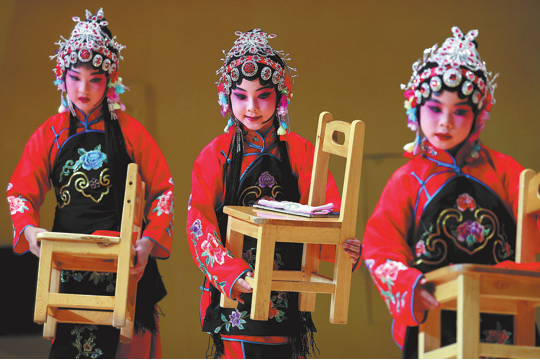Cultural IPs, govt policies make Shanxi a magnet for tourists
Digital projects highlight artistic and architectural value of ancient sites


Shanxi province saw a cultural tourism boom during the 14th Five-Year Plan period (2021-25), driven largely by the rise of popular cultural IPs and supportive government policies.
The province has 531 national key protected cultural sites, the most in China. It is home to more than 50,000 immovable cultural relics, including over 28,000 preserved ancient buildings. Many date back centuries and remain in remarkable condition. Wooden structures built before the Yuan Dynasty (1271-1368) in Shanxi account for more than 80 percent of China's total.
Long overlooked by travelers, these ancient sites have surged in popularity among domestic and international tourists thanks to the breakout success of cultural intellectual properties — a category of intangible assets — that spotlight their architectural and artistic value.
In August 2024, the game Black Myth: Wukong went viral, featuring scenes inspired by Shanxi landmarks including Xiaoxitian Temple in Linfen, Foguang Temple in Xinzhou, and Yuhuang Temple in Jincheng. Xiaoxitian — translated as "the New West" in the game — was built in 1634 and houses thousands of suspended sculptures. The site inspired the game's floating statues encountered by the protagonist, the Destined One.
Xiaoxitian's annual visitors jumped from 30,000 to 687,000 in 2024 and reached about 1.25 million in the first nine months of 2025.
"The development of the scenic area has been a key focus of the local government in recent years," said Liu Xiaogang, director of Xiaoxitian's service center. "We will continue advancing digital projects using VR and AR to make the relics more vivid and offer immersive experiences that showcase the artistry of the sculptures."
Following the game, the animated film Nobody, which also highlights Shanxi landscapes, went viral this year. The provincial tourism authority rolled out themed itineraries such as "Travel with Wukong in Shanxi" and "Little Monster's Pilgrimage Route", blending game and film elements with real-world sites.
The popularity of these IPs aligns with modern cultural sensibilities, said Liu Gaifang, a professor at Shanxi University's School of History and Culture. "Black Myth embodies a spirit of self-determination, while Nobody resonates with the emotional experiences of working individuals, creating a deep connection between traditional culture and contemporary aesthetics," she said.
Technology is also breathing new life into the province's cultural treasures. Shanxi is promoting the integration of AI, AR and other digital tools with tourism development. The "Black Myth: Wukong Encounter Shanxi — Ancient Architecture Digital Art Exhibition", launched in Taiyuan on Oct 31, showcases this fusion.
"With the popularity of the game and the film, ancient Shanxi architecture has become a cultural container that carries emotions and stories," said Wang Aiqin, director of the provincial cultural and tourism department, at the exhibition's opening ceremony. "Shanxi is activating its thousand-year cultural heritage through digital means."
Another boost has come from China's 240-hour visa-free transit policy, which has fueled a wave of short trips by foreign tourists and sparked lively discussions under "China Travel" tags on social media.
Eric Napoli Fernandes, a visitor from Brazil who took part in the 2025 "A Date with China" International Media Tour from Nov 10 to 14, said he was overwhelmed by the province's architectural heritage.
"I've seen the historic buildings in Beijing, but Shanxi's feel older and more authentic; I love this kind of 'antique' flavor — it's exquisitely detailed and full of character," said the 28-year-old. "The intricate woodwork is especially breathtaking, and everything is so well-preserved that you can still walk through it today, as if it never ends — utterly awe-inspiring."
The tour, which began with a temple tour in Taiyuan, was co-hosted by China Daily Website and the Cyberspace Administration of Shanxi. It drew more than 10 foreign influencers and experts from eight countries and regions, including the United States, Germany and Russia.
"When I get home, I can't wait to brag to my friends that I've visited the Wukong filming spot," Napoli said. "A lot of Brazilians think they know what China is like, but once they're here they realize it's far better — more colorful, friendlier, just not what they imagined."
The province is also upgrading its three World Cultural Heritage sites — Pingyao Ancient City, Mount Wutai and the Yungang Grottoes — and improving major tourism roads to strengthen infrastructure and diversify offerings.
"Local governments and cultural heritage authorities should actively collaborate to bring more ancient architecture into public view and gain sustainable vitality through responsible use," said Liu, the Shanxi University professor. "These efforts will not only make Shanxi's ancient architecture a vessel for emotions and stories but also help build a broader societal consensus on cultural heritage preservation and transmission."
Contact the writers at zhouhuiying@chinadaily.com.cn




































